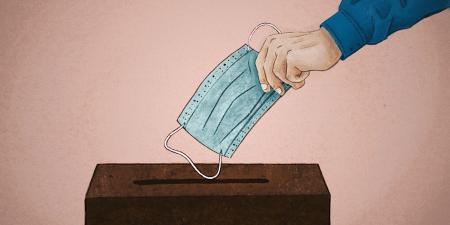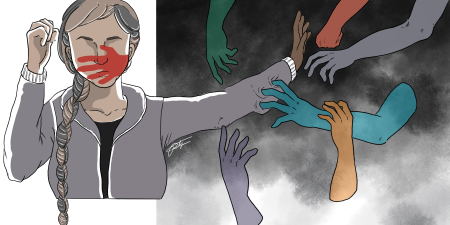Abstract
Racial identity is a complex idea, particularly for American Indian and Alaska Native (AI/AN) populations. The idea of a single AI/AN race developed from a European-American view of phenotypic and cultural differences. It continues to have significant consequences for AI/AN populations within the clinical-medical context. For clinicians, using this flawed category in medical decision making poses ethical challenges and has implications for patient autonomy and justice. This article briefly traces the development of the idea of an AI/AN race, the concerns raised in using this identity marker, and the ethical implications of employing the categorization.
I really feel that identity is a very complicated mixture,
of what you grow up with, what you find out about yourself.
I didn’t want to add any confusion to it. It wouldn’t do me any harm,
but when I asked my extended family about this—and I did go to everyone—
I was told, “It’s not yours to give, Louise.”1
Racial Categorization in Medicine
Racial categories are ubiquitous in modern medicine, particularly in research, health professions education, public health efforts, and clinical practice. Although race as a biological category has been disavowed by professional societies, including the American Public Health Association,2 the American Sociological Association,3 the American Anthropological Association,4 and the American Association of Physical Anthropologists,5 clinicians often invoke biological differences based on racial or ethnic identity—and often a conflation of the 2 categories—to structure diagnostic and treatment approaches to a wide range of conditions, from sickle cell anemia to mental health illnesses.6,7,8,9
In this article, we explore racialization of American Indian and Alaska Native (AI/AN) identity within clinical contexts, tracing the history and development of Native identity as a sociocultural-political identity that continues to affect clinicians’ presumptions about patients’ biologically based disease risk. We then consider ethical implications of using race as a category in clinical practice.
History of Native Identity and AI/AN Racialization
Development of a Native identity predates the current concept of an American Indian “race.” Promulgation of the idea that significant biological and behavioral differences existed between Indigenous peoples and Europeans began at first contact in the Americas. Columbus noted in his journals how cultural practices of the Arawak of the modern-day Bahamas, such as giving whatever they had when asked, differed significantly from Europeans’ transactional gift giving. He interpreted this difference as a kind of inferiority, and concluded that Natives would ultimately make excellent subjects and slaves.10 Over time, such beliefs about the cultural and biological inferiority of Indigenous peoples were coupled with religious ideas and now-debunked social Darwinist theories to justify ensuing genocide and settlement of Indigenous peoples’ lands throughout the period of colonization both in the United States and globally.11
The United States continued an unrelenting expansionist policy that both was justified by the putative underlying biological inferiority of native peoples and justified their continued management. In the United States, Indigenous populations were forcibly removed from their homelands and relocated to distant reservations or coerced into signing treaties that often exploited their ancestral lands.12 A constructed Native identity became more important from a governance standpoint and, in some ways, more biologically real to the US government during the late 19th and early 20th centuries. Indeed, the US government increasingly sought to identify which individuals could be granted (or denied) access to Native lands based on their ancestral ties and family lineage.13
In its bid to eliminate Indigenous presence and open Indigenous lands to further colonization and exploitation, the United States passed the Dawes Act of 1887, which allowed for allotment of reservation land.13 More specifically, the law allowed the federal government to determine which individuals would have access to reservation land, based on a blood quantum of at least one quarter Native. As a result, some communities’ land was legally reduced because many Natives did not meet the minimum threshold, allowing the federal government to distribute land to more “competent” individuals who could sell it to homesteaders and others.13 Although blood quanta criteria developed during this period to establish tribal affiliation were not intended to represent heredity, such hereditarian ideas pervade modern analyses of associations between ancestry and genetics.14 Blood quanta became fundamental to federal policy determining Native identity, and such socially constructed categories have contributed significantly to perceptions of race as hereditary.15
Contemporary conceptions of Indian identity were further cemented after the Indian Reorganization Act of 1934. Federally recognized tribes used a minimum quantum of “Indian blood” to affirm an individual’s tribal enrollment, an important determination that allowed individuals access to federal benefits, including access to health services.15 Issues of the relation of blood quanta to identity and tribal affiliation have emerged as real, everyday problems for Native peoples, something Louise Erdrich literally embodied. Her dilemma was whether being culturally Ojibwe was enough for her or whether she should possibly alter her own family’s understanding of their kinship through DNA analysis and possibly claim certain rights based on blood quanta.
During the mid-20th century, the federal government “terminated” numerous tribes by depriving them of recognized status and benefits and imposed relocation policies on Native communities in an effort to assimilate members of recognized tribes.13,15 Such policies have not only resulted in loss of tribal identity for individuals but also taken a generational toll since, without a minimum blood quantum, one’s ancestral lineage to a tribal nation can be severed both politically and culturally. Faced with the daunting challenge of diminishing populations, many tribes have restructured tribal citizenship criteria to include lineal descent. For many tribes, providing evidence of lineal descent ensures tribal citizenship without individuals having to provide evidence of a minimum blood quantum. Tribal citizenship is complicated, however, considering that many self-identified AI/AN are affiliated formally or informally with tribes that do not have federal or state recognition yet feel they are tribal citizens or compose a distinct cultural group living within the United States.
AI/AN race has been formulated based on federal policies intended to identify individuals who could access federal benefits.
The racialized identity of AI/AN peoples developed to a large extent according to European-American conceptions of race.14 The AI/AN race was formulated based on federal policies intended to identify individuals who could access federal benefits; modern conceptions of DNA and genetics did not play a significant role in the development of an AI/AN race.14 Accordingly, racial categorization is still used to study and articulate social and structural inequities that lead to poor health outcomes and ongoing disparities for Native populations.16 Similarly, medical education has long perpetuated the idea of race as an important biological marker that could explain increased risk for illness.6,17 Moreover, significant research conducted by academics as well as by pharmaceutical companies continues to focus on identifying links between genetics, race, and therapeutics.18,19
Racializing and Clinical Decision Making
Clinical decision-making processes are complex and have been studied extensively. Fundamentally, clinicians integrate research, training, and intuition developed through clinical practice to make judgments about clinical course, diagnosis, and treatment of their patients.20,21 To make such decisions, clinicians often rely on racialized information.20,21,22 Using racialized identity, particularly in treating AI/AN patients, raises significant concerns about the accuracy of racial categorizations.
Racial misclassification of participants in research studies is common due to individual, systemic, and policy-level factors.15 Such misclassification produces wildly varying estimates of outcomes in various studies; in many cases, however, misclassification leads to an underreporting of mortality and morbidity in AI/AN populations and can lead to worsening health disparities.23 Even when misclassification does not affect outcomes in studies using racial categories, the use of racialized identity, whether in large state or national studies or in case-based research, can oversimplify experiences of vastly different tribes or individuals by grouping them into a single category. For example, fetal alcohol spectrum disorder (FASD) has often been racialized and medicalized as a Native problem in Canada because researchers do not account for particular historical, political, or sociocultural factors that lead to FASD.9
A second concern is the use of race as a proxy for genetic heritage in studies and research proposals arguing that there are genetic differences in risk of illness or in protective factors against certain illnesses. For example, although research on alcohol and drug use disorders has identified numerous nonbiological risk factors,21 some studies still seek to establish a genetic link for such disorders.22 These studies identify participants as “Native American” or “American Indian,” based on their enrollment in a tribe. Participant selection based on tribal enrollment does not account for the complexities of race and instead relies on race to study potential genetic predisposition.24,25
Clinical decision making and education in recent years has begun to emphasize reducing risk of illness or mortality in addition to treatment of disease.26 Many clinicians, particularly those treating AI/AN patients, make clinical decisions based on studies that use racial categorizations. However, this use of race has important limitations, particularly for AI/AN populations, as racial categories can form a “weak and ambiguous basis” for making clinical decisions.26 The consequences for medical decision making based on such categories are significant: in any given case, clinicians might overestimate or underestimate the patient’s real disease risk and offer treatment based on incomplete or inaccurate data. Moreover, clinicians might use data that classifies significantly diverse populations as a single racial group.27 Such concerns have important ethical implications.
Ethical Implications
As clinicians and educators concerned about autonomy and justice for AI/AN populations, we evaluate the ethical implications of racializing AI/AN health from these perspectives. Paternalistic attitudes based on the putative racial, religious, and cultural superiority of White Americans fundamentally shaped the experiences of Indigenous people.28 This history still affects patient-clinician relationships by undermining respect for patient autonomy; as such, it becomes particularly important to empower Native patients and to ensure that their autonomy is respected during the clinician-patient encounter. Fundamentally, autonomy is subject to an individual’s ability to use accurate, complete information. Given studies’ racial classification errors and the potential conflation of heredity, genetics, and sociopolitical identity, clinicians’ medical information can be inaccurate or inadequate. Physicians are often left with little choice but to use such data in helping their patients make decisions about their risk of illness and the potential benefit of appropriate treatment. The inability of patients and their physicians to make truly informed decisions results in reduced autonomy and at times less than optimal treatment. As such, the use of racialized criteria in treating AI/AN patients presents unique challenges in improving patient outcomes while upholding patient autonomy.29,30
Similarly, achieving justice is difficult when using racialized data. Contractarian theories of justice require redistribution of resources to correct social inequities, especially when those inequities exist in the setting of historical and ongoing oppression of a group of people.31 A practical redistribution of resources that would correct inequities requires us to identify groups or individuals, as well as their specific needs. Our inability to use data to clearly identify individuals, groups, or the social determinants of health that result in poor outcomes and to make the appropriate clinical decisions based on such information necessarily makes the task of achieving justice for disparate groups and individuals incredibly difficult. Consider the example of alcohol use disorder: using race as a proxy for a biological basis of illness could result in the determination that all AI/AN individuals are at high risk for alcohol use disorder because of genetic predisposition, although it has been shown that numerous, nonbiological criteria affect the prevalence of alcohol use disorder in such communities.32 Similarly, a utilitarian theory of justice would note that an inability to identify the needs of particular groups would impede the task of maximizing benefits and providing resources to achieve the best outcome possible. Justice, according to both contractarian and utilitarian models, would be difficult to achieve in such circumstances.
Conclusion
The racialization of health can be traced to the historical and colonial need for identifying, dehumanizing, and marginalizing the other. Race developed into an important and de facto category for differentiating human groups within state and federal government policies, and the use of racial categorization was later extended to the practice of medicine. The convenience of uncritically using race as a category perpetuates the misunderstanding that there are significant differences between human groups based on biology. A single category of AI/AN race also eliminates (or erases) the important sociopolitical and historical differences between and among Native peoples. Clinicians who engage with and treat Native peoples understand the complex role that race plays in their patients’ everyday lives. Nevertheless, race and racism continue to affect everyday hospital and clinical practices—from mental health treatment to pain management. As such, the concept of race must continuously be interrogated as a medical, legal, and everyday category of difference. Racializing health continues to have both practical and ethical consequences, limiting medicine’s ability to achieve health equity for AI/AN populations as well as impeding communication in clinical encounters and significantly eroding patient autonomy.33 Moreover, racializing health outcomes results in an inadequate assessment of the social determinants of health. Accurate assessment of and optimal care for the patient requires thorough and continuous review of the social determinants of health and structural inequities affecting Native peoples’ everyday lives.
References
-
Louise Erdrich (novelist). Faces of America With Henry Louis Gates, Jr. Public Broadcasting Service. https://www.pbs.org/wnet/facesofamerica/profiles/louise-erdrich/10/. Published 2010. Accessed August 22, 2020.
-
American Public Health Association. Research and intervention on racism as a fundamental cause of ethnic disparities in health. Policy no. 20017. https://www.apha.org/policies-and-advocacy/public-health-policy-statements/policy-database/2014/07/25/10/29/research-and-intervention-on-racism-as-a-fundamental-cause-of-ethnic-disparities-in-health. Published January 1, 2001. Accessed June 6, 2020.
-
American Sociological Association. Statement of the American Sociological Association on the importance of collecting data and doing social scientific research on race. Washington, DC: American Sociological Association; 2003. https://www.asanet.org/sites/default/files/savvy/images/press/docs/pdf/asa_race_statement.pdf. Accessed June 6, 2020.
-
American Anthropological Association. AAA statement on race. https://www.americananthro.org/ConnectWithAAA/Content.aspx?ItemNumber=2583. Adopted May 17, 1998. Accessed June 6, 2020.
- Fuentes A, Ackermann RR, Athreya S, et al. AAPA statement on race and racism. Am J Phys Anthropol. 2019;169(3):400-402.
- Hoffman KM, Trawalter S, Axt JR, Oliver MN. Racial bias in pain assessment and treatment recommendations, and false beliefs about biological differences between blacks and whites. Proc Natl Acad Sci U S A. 2016;113(16):4296-4301.
- Green AR, Carney DR, Pallin DJ, et al. Implicit bias among physicians and its prediction of thrombolysis decisions for black and white patients. J Gen Intern Med. 2007;22(9):1231-1238.
-
Rouse CM. Uncertain Suffering: Racial Health Care Disparities and Sickle Cell Disease. Berkeley, CA: University of California Press; 2009.
- Oldani MJ. Uncanny scripts: understanding pharmaceutical emplotment in the Aboriginal context. Transcult Psychiatry. 2009;46(1):131-156.
-
Zinn H. A People’s History of the United States. New York, NY: Harper & Row; 1990.
-
Dunbar-Ortiz R, Gilio-Whitaker D. “All the Real Indians Died Off”: And 20 Other Myths About Native Americans. Boston, MA: Beacon Press; 2016.
-
Nesper L. The Walleye War: The Struggle for Ojibwe Spearfishing and Treaty Rights. Lincoln, NE: University of Nebraska Press; 2002.
-
Schmidt RW. American Indian identity and blood quantum in the 21st century: a critical review. J Anthropol. 2011;2011:549521.
-
TallBear K. Native American DNA: Tribal Belonging and the False Promise of Genetic Science. Minneapolis, MI: University of Minnesota Press; 2013.
-
Haozous EA, Strickland CJ, Palacios JF, Solomon TGA. Blood politics, ethnic identity, and racial misclassification among American Indians and Alaska Natives. J Environ Public Health. 2014;2014:321604.
- Sarche M, Spicer P. Poverty and health disparities for American Indian and Alaska Native children: current knowledge and future prospects. Ann N Y Acad Sci. 2008;1136(1):126-136.
- Lombardo PA, Dorr GM. Eugenics, medical education, and the Public Health Service: another perspective on the Tuskegee Syphilis experiment. Bull Hist Med. 2006;80(2):291-316.
- Brody H, Hunt LM. BiDil: assessing a race-based pharmaceutical. Ann Fam Med. 2006;4(6):556-560.
- Drwecki BB. Education to identify and combat racial bias in pain treatment. AMA J Ethics. 2015;17(3):221-228.
-
Groopman J. How Doctors Think. Boston, MA: Houghton Mifflin Harcourt; 2008.
-
Montgomery K. How Doctors Think: Clinical Judgment and the Practice of Medicine. New York, NY: Oxford University Press; 2006.
-
Kaufman JS, Cooper RS. Use of racial and ethnic identity in medical evaluations and treatments. In: Whitmarsh I, Jones DS, eds. What’s the Use of Race? Modern Governance and the Biology of Difference. Cambridge, MA: MIT Press; 2010:188-206.
-
Nagle R. Native Americans being left out of US coronavirus data and labelled as “other.” Guardian. April 24, 2020. https://www.theguardian.com/us-news/2020/apr/24/us-native-americans-left-out-coronavirus-data. Accessed August 22, 2020.
- Ehlers CL, Gizer IR. Evidence for a genetic component for substance dependence in Native Americans. Am J Psychiatry. 2013;170(2):154-164.
- Mulligan CJ, Robin RW, Osier M V, et al. Allelic variation at alcohol metabolism genes (ADH1B, ADH1C, ALDH2) and alcohol dependence in an American Indian population. Hum Genet. 2003;113(4):325-336.
- Bell HS, Odumosu F, Martinez-Hume AC, Howard HA, Hunt LM. Racialized risk in clinical care: clinician vigilance and patient responsibility. Med Anthropol. 2019;38(3):224-238.
- Metzl JM, Roberts DE. Structural competency meets structural racism: race, politics, and the structure of medical knowledge. Virtual Mentor. 2014;16(9):674-690.
- Jones DS. The persistence of American Indian health disparities. Am J Public Health. 2006;96(12):2122-2134.
- Harris R, Nelson LA, Muller C, Buchwald D. Stroke in American Indians and Alaska Natives: a systematic review. Am J Public Health. 2015;105(8):e16-e26.
- Rhoades DA, Lapp T. Racial misclassification and disparities in cardiovascular disease among American Indians and Alaska Natives. Circulation. 2005;111(10):1250-1256.
-
Rawls J. A Theory of Justice. Cambridge, MA: Belknap Press/Harvard University Press; 1971.
-
Park-Lee E, Lipari RN, Bose J, et al. Substance use and mental health issues among US-born American Indians or Alaska Natives residing on and off tribal lands. CBHSQ Data Review. July 2018. https://www.samhsa.gov/data/sites/default/files/cbhsq-reports/DRAIANTribalAreas2018/DRAIANTribalAreas2018.pdf. Accessed August 22, 2020.
- Carese JA, Rhodes LA. Bridging cultural differences in medical practice: the case of discussing negative information with Navajo patients. J Gen Intern Med. 2000;15(2):92-96.



